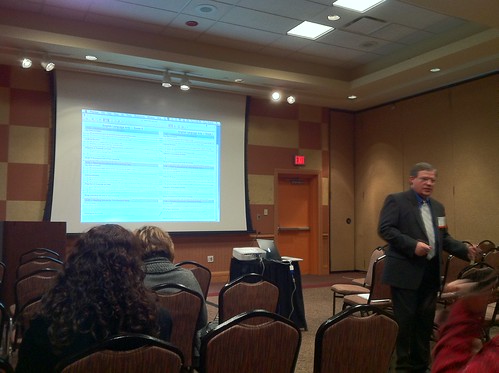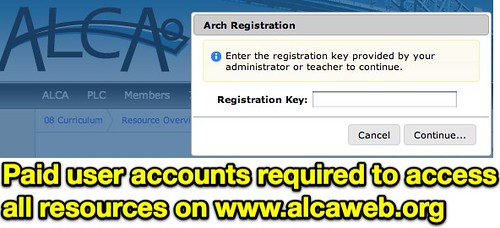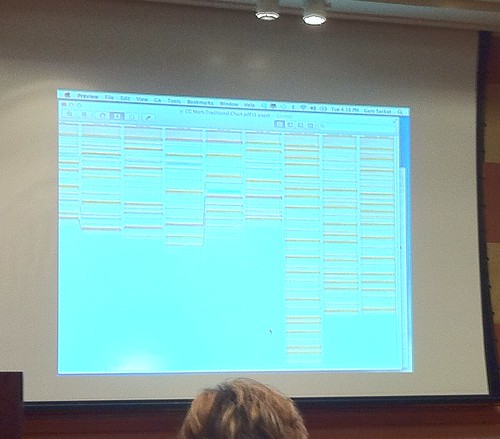These are my notes from the Gary Sacket’s presentation, “Standards Mapping the Common Core to Everyday Instruction and Teaching” at the February 7, 2012 Oklahoma Technology Association / Encycl-Media Conference. He is with the Gary Sacket Aurora Learning Community Association (ALCA). MY THOUGHTS AND COMMENTS ARE IN ALL CAPS. The official session description was:
Discover how easy it is to Standards Map the Common Core State Standards to lesson plans- curriculum- instruction- and learning. Why Standards Map? It documents not only WHAT standard is aligned to a specific lesson- test item- or instructional strategy- but also the specific content (nouns)- skills (verbs)- level of rigor (Bloom Level)- I?Can statement- Big Idea- and Essential Question. It’s alignment with rigor!
teachers will have to use the library in different ways under Common Core State Standards
– requires collaboration between teachers to require different kinds of collaboration
www.alcaweb.org
– curriculum threads standards
We have created a 14 foot long wall poster that is the reading common core (MY COMMENT: WHEN I ASKED GARY FOR THE LINK TO THIS MAP, HE SAID ONLY PAYING CUSTOMERS WITH REGISTRATION CODES AND LOGIN ACCOUNTS CAN ACCESS ANY OF THE RESOURCES HE’S SHARING TODAY. 🙁
Wouldn’t it be nice if students in older grade levels could create curriculum and materials for use by younger students
– wouldn’t it be nice for students to create and save artifacts of their learning which can be maintained year-to-year?
If you don’t do these things, it is going to be a LOT harder to implement the CCSS
Need to be able to assess how students can use a skill in ‘unpredictable ways’
– for the past 16 years we have been dumbing down students, because we have been focusing mostly on lower level skills
We (ALCA) have been doing research for years, we are driven purely by research, not whether we make money or create a product that sells
– “we are like Steve Jobs who built a computer in his own garage, we are doing it our own way”
– we’ve been doing this since 1997
– the problem up to this point is the system wasn’t in place for school districts, with carrots and sticks
“I can tell you this for sure, the Common Core isn’t ever going to go away”
How many reading standards in CCSS K-12?
This is the ‘traditional’ CCSS curriculum map for Algebra I in the U.S. developed by www.alcaweb.org. (MY COMMENT: I’M WONDERING WHY IT IS HELPFUL TO VIEW THIS, IN THIS ZOOMED OUT FORMAT?)
Standards mapping is two things:
1- unwrapping or unpacking: breaking standard apart so you can get all the information out of it, so kids / parents / teachers can relate to it
2- ‘wrapping it back’ around test items, a lesson plan, a website you found
MY COMMENT: THIS STEP 2 IS CONNECTING THE ‘UNWRAPPED STANDARDS’ TO LEARNING TASKS FOR STUDENTS
Whatever you do, you have to be able to unpack the standards as a teacher
MY COMMENT AND IDEA: I ASKED GARY HOW MUCH IT COSTS FOR A SCHOOL DISTRICT TO GET ACCESS TO ALL ITS ‘UNPACKED CCSS STANDARDS.’ HE SAID HE DIDN’T WANT TO GET INTO PRICING TODAY. I’M THINKING THIS IS A CRITICAL QUESTION. IT’S ALSO AN IDEA FOR A COLLABORATION AMONG OKLAHOMA DISTRICTS. AS WE HAVE TEACHERS UNPACK STANDARDS, WHY DON’T WE HAEV THOSE DOCUMENTS SHARED OPENLY AS PUBLIC GOOGLE DOCS? THEN ANYONE COULD UTILIZE AND BUILD ON THOSE PRODUCTS? I’M SEEING AN AMAZING AMOUNT OF WORK THAT ALCA HAS DONE UNPACKING THESE STANDARDS, BUT I’M THINKING THERE ARE GREAT OPPORTUNITIES HERE FOR SCHOOL DISTRICTS TO OPENLY LICENSE (WITH CREATIVE COMMONS) THEIR OWN ‘UNPACKED STANDARDS’ FOR ANYONE TO USE.
Larry Ainsworth is the ‘father of unpacking’
– no one of the planet has done this… what I am about to show you
– it takes a lot of time and work to unpack standards
Where does the vocabulary list for this come from?
Columns for the ALAWEB unwrapping:
1 Content
– relevant information
– paraphrased information
– List
2 Skills
– recall
– gather
– summarize / paraphrase
– provide
3 Learning Targets
– I can…. statements
4 Big Ideas
5 Essential Questions
You never want to show a student “the big ideas”
Teachers on the east coast particularly will put the ‘big ideas’ and ‘essential questions’ on the wall, so at the end of the day the teacher can point to them and ask students to describe/discuss how those were addressed in our activities of the day
Wiggins and others have done the research and found: If you don’t tie learning students are doing to a ‘global concept’ that a student can relate to forever, s/he is NOT going to remember it
– must tie to a global set of knowledge
Students must use all four: reading, writing, speaking, listening
– kids are using four different parts of their brain, so they have a greater opportunity to burn it to long term memory
“Measurement and Data standard goes away in CCSS math standards after grade 5”
There are about 200 school districts in OKlahoma who are members and now actively contributing to these databases of resources
– schools retain ownership over materials created from a legal standpoint
– we hope schools share their products
I’M WONDERING IF ALCA PERMITS SCHOOL DISTRICTS TO SPECIFICALLY LICENSE THEIR UNPACKED STANDARDS UNDER CREATIVE COMMONS AND SHARE THEM ON THE OPEN, VERSUS THE CLOSED WEB?
My brother is the science coordinator in Enid, now I’m going to copy a benchmark test they created
– I am using a ‘room key’ as a password to access this
“sdMev”
– use that room code to import that ‘virtual room’ in our ‘learning community management system’ (more than Moodle, you can document TLE in an assessment way, not an evaluation way – teachers can self-assess, create smart goals. Also teams can do action research on specific competencies or skills)
I’m going to show you know how you can wrap an unpacked standard around a test item
– teachers are going to have to document how they are teaching
– this process allows for documentation of teacher instruction, as well as student learning
– using rubrics for formative assessment, tests, also other strategies
Story of an Ag teacher who is using iPads with students to assess how they showed sheep at a stock show
– students can do similar things with water quality data
– in lower grades, students have to participate in research
– need to engage students up and down grade levels
Most important takeaway today was shared by
– every system there will let you connect it to a standard, and then it’s ‘magically aligned’
– the level of rigor in terms of alignments with other tools (not ours) is too shallow
– systems that just let you attach a standard create too much grey area for a principal to talk to a teacher, or teachers to talk to a teacher
– those systems are always open to interpretation when we ask, “how is this aligned?”
– “most systems just link”
With the CCSS you need to assess two or more standards in every question
Right now we are doing leadership retreats and workshops with school administrators
– working with superintendents as well as principals
– all of them have to work with TLE
We created this for Oklahoma Career Tech, we call it Professional Development
– we don’t know yet if we
– it will be a personal learning network for students
Schools start with ePASS, Dibbles, anything, our system can ingest anything
– “our system never requires help from your IT department, we do it all”
– “we prefer to do the [student test score result] importing, because Pearson isn’t known for providing ‘clean’ data”
We are going to have science institutes, and have science teachers create content
– ‘we are going to Missouri next’
– we want Oklahoma to be a national model for this
“We paid 5 or 6 people to unpack all the CCSS standards last summer. We think individual teachers should only unpack 1 or 2 standards, it’s very time consuming.”
MY CLOSING COMMENT: I ASKED GARY IF THEY LICENSE ACCESS TO THEIR SYSTEM ON A PER SEAT BASIS, AND HE SAID YES. IT LOOKS LIKE HE WANTS SCHOOLS TO EMBRACE THEIR PROPRIETARY SYSTEM AS A COMPREHENSIVE LEARNING MANAGEMENT SYSTEM (LMS) WHICH WOULD REPLACE MOODLE, BLACKBOARD, ETC. I AM VERY GLAD TO HEAR GARY SHARE THIS INFO, I WANT TO LEARN MORE. I’M CONCERNED THAT OKLAHOMA SCHOOLS AND TEACHERS ARE NOT BEING CURRENTLY ENCOURAGED BY ANYONE (APPARENTLY) TO OPENLY SHARE AND LICENSE UNDER CREATIVE COMMONS UNPACKED CCSS AS WELL AS LESSONS.
Sign up for the ALCA sacking [at] alcaweb [dot] org
If you enjoyed this post and found it useful, subscribe to Wes’ free newsletter. Check out Wes’ video tutorial library, “Playing with Media.” Information about more ways to learn with Dr. Wesley Fryer are available on wesfryer.com/after.
On this day..
- Sharing My Enthusiasm for Space Exploration – 2022
- Triple Threat in Tech: A Reflection – 2016
- Visualize: Sticky Learning (Visual Notetaking) – 2014
- A Renaissance in Educational Podcasting – 2014
- Recorded Audio & Resources from my #otaem12 Presentations Today – 2012
- Can You Do That? Legal Issues in Tech Administration #otaem12 – 2012
- Visioning New Schools with David Warlick – 2012
- Anywhere, Anytime Learning by Janet Barresi – 2012
- Montana Voices: Digital Vision for Schools 2011 Challenge #mtvision – 2011
- Learning with iPad #msmeca11 – 2011




Comments
One response to “Standards Mapping the Common Core to Everyday Instruction and Teaching”
Thanks for your notes, Wes. I had to go to an NBCT meeting. Glad I did, because there were 4 McGen candidate there with questions (including one who is starting the process this year – even with all the problems with the legislature right now). Anyway, I was disappointed because I thought this session would be about how to do just what you were talking about. I guess I’ll have to find other tools to help me work on that.